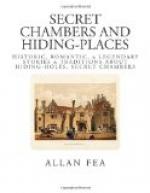CHAPTER XII
HIDING-PLACES IN JACOBITE DWELLINGS AND IN SCOTTISH CASTLES AND MANSIONS
During the Jacobite risings of 1715 and 1745 some of the “priest’s holes” in the old Roman Catholic houses, especially in the north of England and in Scotland, came into requisition not only for storing arms and ammunition, but, after the failure of each enterprise, for concealing adherents of the luckless House of Stuart.
In the earlier mansion of Worksop, Nottinghamshire (burnt down in 1761), there was a large concealed chamber provided with a fireplace and a bed, which could only be entered by removing the sheets of lead forming the roofing. Beneath was a trap-door opening to a precipitous flight of narrow steps in the thickness of a wall. This led to a secret chamber, that had an inner hiding-place at the back of a sliding panel. A witness in a trial succeeding “the ’45” declared to having seen a large quantity of arms there in readiness for the insurrection.
The last days of the notorious Lord Lovat are associated with some of the old houses in the north. Cawdor Castle, Nairnshire, and Netherwhitton, in Northumberland, claim the honour of hiding this double-faced traitor prior to his arrest. At the former is a small chamber near the roof, and in the latter is a hiding-place measuring eight feet by three and ten feet high. Nor must be forgotten the tradition of Mistress Beatrice Cope, behind the walls of whose bedroom Lovat (so goes the story) was concealed, and the fugitive, being asthmatical, would have revealed his whereabouts to the soldiers in search of him, had not Mistress Cope herself kept up a persistent and violent fit of coughing to drown the noise.
A secret room in the old Tudor house Ty Mawr, Monmouthshire, is associated with the Jacobite risings. It is at the back of “the parlour” fireplace, and is entered through a square stone slab at the foot of the staircase. The chamber is provided with a small fireplace, the flue of which is connected with the ordinary chimney, so as to conceal the smoke. The same sort of thing may be seen at Bisham Abbey, Berks.




